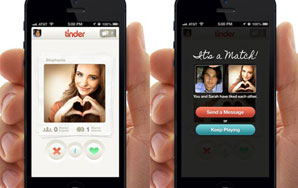Location, Location, Location: Love In The Time Of Tinder
Over the past years we have seen the rise of GPS becoming intrinsic to our digital lives. From Facebook to Foursquare to Google, the divide between cyberspace and meat-space (term for 'real life') seems to be becoming smaller, making dating an obvious next stop.


Growing up, my father liked to offer up little sayings whenever he got a chance, which to this day my sister and I can repeat at the drop of a hat.
For a while, he was in the real estate business and would routinely ask me, “Son, what is the most important thing to consider when buying or selling a home?” And I would always answer: location, location, location. Of course, all of these sayings weren’t originally his. He just was the first person to ever say them to us, and they stuck.
This phrase ‘location, location, location,’ outside of my father’s usage, has been most commonly reserved for the realm of real estate; however that could be changing in the near future.
In December 2012, over 25 million people accessed dating profiles via a mobile device, using location-based apps according to the Chicago Tribune, ‘Love in the time of GPS.’ This term ‘location-based’ means they use a mobile devices’ GPS signal to match users in regards to proximity. Popular examples of location-based dating apps are apps such as Tinder, Grindr, and even OkCupid who in 2011 added a GPS aspect to their users online dating experience.
This new form of dating should not come as a surprise. Over the past years we have seen the rise of GPS becoming intrinsic to our digital lives. From Facebook to Foursquare to Google, the divide between cyberspace and meat-space (term for ‘real life’) seems to be becoming smaller, making dating an obvious next stop. Having GPS a part of your everyday life is convenient and welcomed in some aspects. For example: using your phone to get directions to the closest five pizza places in .548 seconds. But in terms of dating, it has the ability to come off a little Big Brother-esque, while raising new questions.
Questions like: if our dating lives become more focused on our geographic coordinates will ‘location, location, location’ be most important when logging online to casually look at prospects? Will I, personally, need to move to Boystown or other gay-borhoods with high densities of other gay men to have any hopes of meeting someone? And, are these anxieties even any different than others that arose before the time of digital dating?
When online dating became popular in the 1990s, one of the biggest problems around meeting someone online was geography. You would meet ‘Mr. Perfect’ on your favorite site, but soon find out he lives states away and he stayed ‘perfect’ in Phoenix while you stayed single in whichever city you called home.
With this in mind, having more location-based dating sites is helpful. It eliminates one of the bigger barriers in dating and meeting someone: distance. By using these apps, if you hit it off with someone, grabbing coffee is not a huge undertaking since they are reasonably close at that moment.
On the other hand, everyone has had their share of bad dates, most leaving you never wanting to see that person again (that whole ‘kiss a lot of toads’ saying is applicable here.) So, if your dating profile shows users in your immediate area and you know that you have a high chance of meeting a toad, then knowing Mr. Toad lives down the street after the date could be awkward.
Whether we like it or not, this new era of dating is here and looks as though it’s to stay. But should all of this GPS stuff even worry us that much? Isn’t dating already all about where you live, internet involved or not?
This past February, the residential real estate website Trulia decided to figure out what the best places to live if you were single, with their chief economist and head of analytics, Jed Kolko taking the lead. What they found was there are already specific places in which certain gendered people are living alone at higher rates. For men cities like: Las Vegas; Honolulu; Palm Bay, Fla.; Gary, Ind.; and San Jose, Calif., took the lead. And for women, places like: Bethesda, Md.; Washington; Boston; New York; and Raleigh, N.C. were on top of Trulia’s list.
With this in mind, we can see there already seems to be a discrepancy with place vs. relationship status vs. gender. GPS won’t ease this problem, but instead as love and GPS begin to become more and more intrinsic to one another within the realm of online dating, one thing that we may become more painfully aware of is just how isolated we may be.
If you are logging onto location-based apps like Grindr or Blendr and still not having luck, it may really have to do with where you are and not who you are. Within this potential future, the old phrase ‘location, location, location’ will not only be something to consider when looking at real estate to purchase a home, but also — and more importantly, to most — something to consider when trying to find real estate for the heart.
A major take away from all of this talk on GPS and dating is that these technologies aren’t showing you anything new. Having your profile linked to your geographic coordinates isn’t making folks magically appear in your neighborhood or city block; instead they are allowing one an easier and faster way to connect with people in the immediate area in a way that’s less awkward than approaching them at a coffee shop with hopes that they say ‘yes’ to a date and are single. Plus, even with the rise of GPS technology on dating sites, some data is still suggesting more people are meeting in real life rather than online.
A 2010 study by Match.com found that the most common place to meet your spouse is work/school. Second is through a friend, and third is online. This at the moment is good news for all of you that may be currently cringing at this idea brought up. So if dating online and GPS worries you, don’t sweat! As long as you have a job, school, or friends then the odds are in your favor.
But if you lack all of those… well, I hear OkCupid is really great, and even free. 




